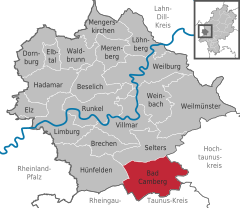Bad Camberg | |
|---|---|
 Old mayor’s house in Erbach | |
Location of Bad Camberg within Limburg-Weilburg district  | |
| Coordinates: 50°18′N 8°16′E / 50.300°N 8.267°E | |
| Country | Germany |
| State | Hesse |
| Admin. region | Gießen |
| District | Limburg-Weilburg |
| Government | |
| • Mayor (2022–28) | Daniel Rühl[1] (CDU) |
| Area | |
| • Total | 54.64 km2 (21.10 sq mi) |
| Elevation | 209 m (686 ft) |
| Population (2022-12-31)[2] | |
| • Total | 14,294 |
| • Density | 260/km2 (680/sq mi) |
| Time zone | UTC+01:00 (CET) |
| • Summer (DST) | UTC+02:00 (CEST) |
| Postal codes | 65520 |
| Dialling codes | 06434, 06483 |
| Vehicle registration | LM, WEL |
| Website | www.bad-camberg.de |
Bad Camberg (German: [baːt ˈkambɛʁk] ) is, with 14,500 inhabitants, the second largest town in Limburg-Weilburg district in Hesse, Germany, as well as the southernmost town in the Regierungsbezirk of Gießen. It is located in the eastern Taunus in the Goldener Grund (“Golden Ground”) some 30 km north of Wiesbaden, 18 km southeast of Limburg an der Lahn, and 44 km northwest of Frankfurt, as well as on the German Timber-Frame Road. Bad Camberg is the central community of the Goldener Grund with good infrastructure, and a lower centre partly with a middle centre's function.
The recognized Kneipp resort is Hesse's oldest and Germany's third oldest. In the outlying centre of Oberselters is found a mineral spring that gives forth the well known Selterswasser, often known in English as “seltzer”. The town's landmark is the Kreuzkapelle.
- ^ "Ergebnisse der jeweils letzten Direktwahl von Landrätinnen und Landräte sowie (Ober-)Bürgermeisterinnen und (Ober-)Bürgermeister in Hessen, Stand 13.04.2023" (XLS) (in German). Hessisches Statistisches Landesamt.
- ^ "Bevölkerung in Hessen am 31.12.2022 nach Gemeinden" (XLS) (in German). Hessisches Statistisches Landesamt. June 2023.


